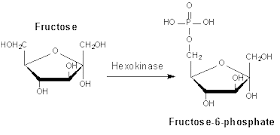There is nothing new in the fact that glycolysis serves to degrade glucose, the most abundant monosaccharide in our diet. But what happens to other monosaccharides we eat? Can we degrade them for energy? If so, can we rely on glycolysis for this?
The answer to both questions is yes. Indeed, glycolysis allows the degradation not only of glucose but also of other monosaccharides such as fructose, galactose and mannose. For that, these monosaccharides have to be converted into glycolytic intermediates.
FructoseFructose is obtained from the diet in foods such as fruits, honey and cereals, for example.
The answer to both questions is yes. Indeed, glycolysis allows the degradation not only of glucose but also of other monosaccharides such as fructose, galactose and mannose. For that, these monosaccharides have to be converted into glycolytic intermediates.
FructoseFructose is obtained from the diet in foods such as fruits, honey and cereals, for example.

In extrahepatic tissues, which lack the enzyme glucocinase, fructose is converted to fructose-6-phosphate by hexokinase, the first enzyme of glycolysis. It should be noted that the hexokinase uses glucose as preferred substrate, but can also phosphorylate other monosaccharides such as fructose, for example. Since fructose-6-phosphate is an intermediate of glycolysis, it can then follow the normal glycolytic pathway.
Alternatively, in liver, fructose has to undergo a different process, because the glucocinase is very specific for glucose, failing therefore to phosphorylate fructose. In this case, fructose is phosphorylated by frutocinase, producing fructose-1-phosphate. Thereafter, the aldolase, which is the 4th enzyme of glycolysis, acts on fructose-1-phosphate, cleaving it to dihydroxyacetone phosphate and glyceraldehyde. The former molecule is already an intermediate of glycolysis, so it can proceed in that pathway, but not the latter. Therefore, the glyceraldehyde is subsequently phosphorylated by glyceraldehyde kinase, leading to glyceraldehyde-3-phosphate, which is also a glycolytic intermediate.
GalactoseGalactose is found mainly in dairy products because it is a component of lactose.
GalactoseGalactose is found mainly in dairy products because it is a component of lactose.
Galactose is first phosphorylated to galactose-1-phosphate by galactocinase. Then galactose-1-phosphate will receive an UDP molecule, resulting in UDP-galactose. This reaction is catalyzed by galactose-1-phosphate uridyl transferase. UDP-galactose is then epimerized to UDP-glucose, by the action of UDP-galactose-4-epimerase. The UDP-glucose undergoes an exchange of its UDP portion by a phosphoryl group, producing glucose-1-phosphate, which is then converted to glucose-6-phosphate (glycolytic intermediate) by the action of phosphoglucomutase (this enzyme also participates in the metabolism of glycogen...).
Mannose
Mannose can be found, for example, in beans, peas, or similar vegetables.
Mannose can be found, for example, in beans, peas, or similar vegetables.

Mannose is phosphorylated by hexokinase originating mannose-6-phosphate. The mannose-6-phosphate is converted to fructose-6-phosphate (a glycolytic intermediate) by fosfomanose isomerase.
Main bibliographic sources:
- Quintas A, Freire AP, Halpern MJ, Bioquímica - Organização Molecular da Vida, Lidel
- Nelson DL, Cox MM, Lehninger - Principles of Biochemistry, WH Freeman Publishers








How may ATP are produced for a sucrose molecule
ReplyDelete